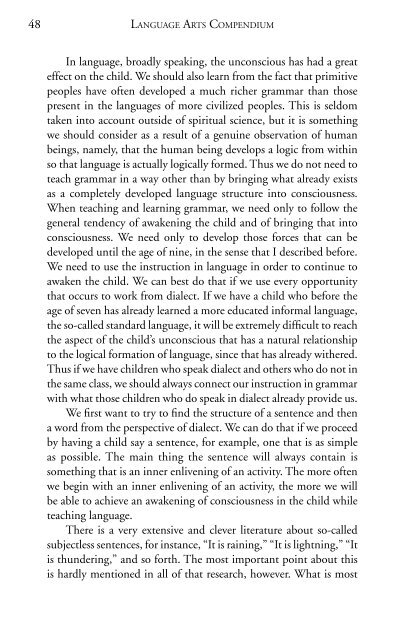Teaching Language arTs in The WaLdorf schooL
Teaching Language arTs in The WaLdorf schooL
Teaching Language arTs in The WaLdorf schooL
Create successful ePaper yourself
Turn your PDF publications into a flip-book with our unique Google optimized e-Paper software.
48<br />
<strong>Language</strong> Arts Compendium<br />
In language, broadly speak<strong>in</strong>g, the unconscious has had a great<br />
effect on the child. We should also learn from the fact that primitive<br />
peoples have often developed a much richer grammar than those<br />
present <strong>in</strong> the languages of more civilized peoples. This is seldom<br />
taken <strong>in</strong>to account outside of spiritual science, but it is someth<strong>in</strong>g<br />
we should consider as a result of a genu<strong>in</strong>e observation of human<br />
be<strong>in</strong>gs, namely, that the human be<strong>in</strong>g develops a logic from with<strong>in</strong><br />
so that language is actually logically formed. Thus we do not need to<br />
teach grammar <strong>in</strong> a way other than by br<strong>in</strong>g<strong>in</strong>g what already exists<br />
as a completely developed language structure <strong>in</strong>to consciousness.<br />
When teach<strong>in</strong>g and learn<strong>in</strong>g grammar, we need only to follow the<br />
general tendency of awaken<strong>in</strong>g the child and of br<strong>in</strong>g<strong>in</strong>g that <strong>in</strong>to<br />
consciousness. We need only to develop those forces that can be<br />
developed until the age of n<strong>in</strong>e, <strong>in</strong> the sense that I described before.<br />
We need to use the <strong>in</strong>struction <strong>in</strong> language <strong>in</strong> order to cont<strong>in</strong>ue to<br />
awaken the child. We can best do that if we use every opportunity<br />
that occurs to work from dialect. If we have a child who before the<br />
age of seven has already learned a more educated <strong>in</strong>formal language,<br />
the so-called standard language, it will be extremely difficult to reach<br />
the aspect of the child’s unconscious that has a natural relationship<br />
to the logical formation of language, s<strong>in</strong>ce that has already withered.<br />
Thus if we have children who speak dialect and others who do not <strong>in</strong><br />
the same class, we should always connect our <strong>in</strong>struction <strong>in</strong> grammar<br />
with what those children who do speak <strong>in</strong> dialect already provide us.<br />
We first want to try to f<strong>in</strong>d the structure of a sentence and then<br />
a word from the perspective of dialect. We can do that if we proceed<br />
by hav<strong>in</strong>g a child say a sentence, for example, one that is as simple<br />
as possible. <strong>The</strong> ma<strong>in</strong> th<strong>in</strong>g the sentence will always conta<strong>in</strong> is<br />
someth<strong>in</strong>g that is an <strong>in</strong>ner enliven<strong>in</strong>g of an activity. <strong>The</strong> more often<br />
we beg<strong>in</strong> with an <strong>in</strong>ner enliven<strong>in</strong>g of an activity, the more we will<br />
be able to achieve an awaken<strong>in</strong>g of consciousness <strong>in</strong> the child while<br />
teach<strong>in</strong>g language.<br />
<strong>The</strong>re is a very extensive and clever literature about so-called<br />
subjectless sentences, for <strong>in</strong>stance, “It is ra<strong>in</strong><strong>in</strong>g,” “It is lightn<strong>in</strong>g,” “It<br />
is thunder<strong>in</strong>g,” and so forth. <strong>The</strong> most important po<strong>in</strong>t about this<br />
is hardly mentioned <strong>in</strong> all of that research, however. What is most

















